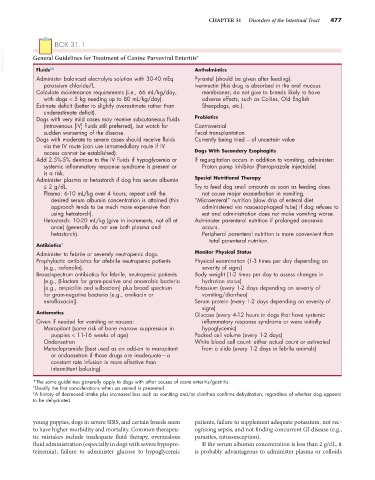Page 505 - Small Animal Internal Medicine, 6th Edition
P. 505
CHAPTER 31 Disorders of the Intestinal Tract 477
BOX 31.1
VetBooks.ir General Guidelines for Treatment of Canine Parvoviral Enteritis*
Fluids
†‡
Administer balanced electrolyte solution with 30-40 mEq Anthelmintics
Pyrantel (should be given after feeding).
potassium chloride/L. Ivermectin (this drug is absorbed in the oral mucous
Calculate maintenance requirements (i.e., 66 mL/kg/day, membranes; do not give to breeds likely to have
with dogs < 5 kg needing up to 80 mL/kg/day). adverse effects, such as Collies, Old English
Estimate deficit (better to slightly overestimate rather than Sheepdogs, etc.).
underestimate deficit).
Dogs with very mild cases may receive subcutaneous fluids Probiotics
(intravenous [IV] fluids still preferred), but watch for Controversial
sudden worsening of the disease. Fecal transplantation
Dogs with moderate to severe cases should receive fluids Currently being tried – of uncertain value
via the IV route (can use intramedullary route if IV
access cannot be established). Dogs With Secondary Esophagitis
Add 2.5%-5% dextrose to the IV fluids if hypoglycemia or If regurgitation occurs in addition to vomiting, administer:
systemic inflammatory response syndrome is present or Proton pump inhibitor (Pantoprazole injectable)
is a risk.
Administer plasma or hetastarch if dog has serum albumin Special Nutritional Therapy
≤ 2 g/dL. Try to feed dog small amounts as soon as feeding does
Plasma: 6-10 mL/kg over 4 hours; repeat until the not cause major exacerbation in vomiting.
desired serum albumin concentration is attained (this “Microenteral” nutrition (slow drip of enteral diet
approach tends to be much more expensive than administered via nasoesophageal tube) if dog refuses to
using hetastarch). eat and administration does not make vomiting worse.
Hetastarch: 10-20 mL/kg (give in increments, not all at Administer parenteral nutrition if prolonged anorexia
once) (generally do not use both plasma and occurs.
hetastarch). Peripheral parenteral nutrition is more convenient than
total parenteral nutrition.
Antibiotics †
Administer to febrile or severely neutropenic dogs. Monitor Physical Status
Prophylactic antibiotics for afebrile neutropenic patients Physical examination (1-3 times per day depending on
(e.g., cefazolin). severity of signs)
Broad-spectrum antibiotics for febrile, neutropenic patients Body weight (1-2 times per day to assess changes in
(e.g., β-lactam for gram-positive and anaerobic bacteria hydration status)
[e.g., ampicillin and sulbactam] plus broad spectrum Potassium (every 1-2 days depending on severity of
for gram-negative bacteria [e.g., amikacin or vomiting/diarrhea)
enrofloxacin]). Serum protein (every 1-2 days depending on severity of
signs)
Antiemetics Glucose (every 4-12 hours in dogs that have systemic
Given if needed for vomiting or nausea: inflammatory response syndrome or were initially
Maropitant (some risk of bone marrow suppression in hypoglycemic)
puppies < 11-16 weeks of age) Packed cell volume (every 1-2 days)
Ondansetron White blood cell count: either actual count or estimated
Metoclopramide (best used as an add-on to maropitant from a slide (every 1-2 days in febrile animals)
or ondansetron if those drugs are inadequate—a
constant rate infusion is more effective than
intermittent bolusing).
*The same guidelines generally apply to dogs with other causes of acute enteritis/gastritis.
† Usually the first considerations when an animal is presented.
‡ A history of decreased intake plus increased loss such as vomiting and/or diarrhea confirms dehydration, regardless of whether dog appears
to be dehydrated.
young puppies, dogs in severe SIRS, and certain breeds seem patients, failure to supplement adequate potassium, not rec-
to have higher morbidity and mortality. Common therapeu- ognizing sepsis, and not finding concurrent GI disease (e.g.,
tic mistakes include inadequate fluid therapy, overzealous parasites, intussusception).
fluid administration (especially in dogs with severe hypopro- If the serum albumin concentration is less than 2 g/dL, it
teinemia), failure to administer glucose to hypoglycemic is probably advantageous to administer plasma or colloids

